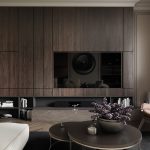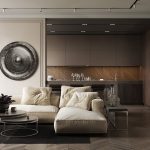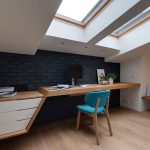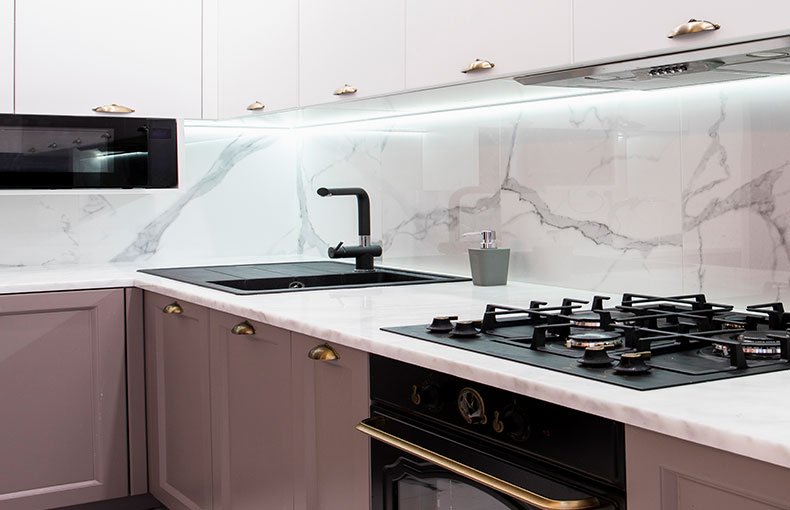Top 10 Tips for Your Kitchen Interior Design
Designing a kitchen can be both an exciting and daunting task. The kitchen is the heart of the home, a place where functionality and style must coalesce seamlessly. Here are ten comprehensive tips to help you achieve a perfect balance between aesthetics and practicality in your kitchen design.
- Understand Your Kitchen Layout
The layout of your kitchen is paramount in determining its functionality. Common layouts include U-shaped, L-shaped, galley, and open-plan designs. Each has its advantages:
U-shaped kitchens maximize storage and counter space, ideal for larger kitchens.
L-shaped kitchens are versatile, allowing for an open-plan feel and the possibility of adding an island.
Galley kitchens are efficient in terms of movement and are perfect for small spaces.
Open-plan kitchens integrate with living areas, promoting a social and inclusive environment.
- Prioritize the Work Triangle
The work triangle principle involves placing the sink, stove, and refrigerator at three points of a triangle to ensure efficient movement. This setup minimizes the steps between tasks, making cooking and cleaning more convenient. Keep the sides of the triangle between 4 to 9 feet for optimal functionality. - Maximize Storage Solutions
Ample storage is crucial in a kitchen to keep it clutter-free. Utilize a mix of cabinets, drawers, and shelves:
Pull-out cabinets make accessing items at the back easier.
Deep drawers can store pots and pans efficiently.
Open shelves add a decorative element and make frequently used items easily accessible.
Consider adding customized storage solutions like spice racks, cutlery dividers, and corner cabinets to make the most of every inch.
- Choose Durable and Easy-to-Clean Materials
Kitchens are high-traffic areas subject to spills and splatters, so choose materials that are both durable and easy to clean:
Quartz countertops are stain-resistant and low-maintenance.
Ceramic or porcelain tiles are ideal for backsplashes as they are easy to wipe down.
Stainless steel appliances and sinks are durable and give a modern touch.
- Incorporate Sufficient Lighting
A well-lit kitchen is essential for both functionality and ambiance. Layer your lighting with:
Ambient lighting: Ceiling fixtures or recessed lighting provide overall illumination.
Task lighting: Under-cabinet lights focus on work areas like countertops and stoves.
Accent lighting: Pendant lights or LED strips highlight features and add a decorative element.
- Select a Cohesive Color Scheme
A cohesive color scheme can make your kitchen appear more spacious and inviting. Neutral tones like white, beige, and gray create a clean and timeless look. You can add pops of color through:
Backsplashes: A colorful tile backsplash can serve as a focal point.
Cabinetry: Consider painting your lower cabinets a bold color while keeping upper cabinets neutral.
Accessories: Brightly colored utensils, pots, or even a vibrant kettle can add character.
- Opt for Quality Fixtures and Hardware
Investing in high-quality fixtures and hardware can enhance the overall look and functionality of your kitchen:
Faucets: Choose a faucet with a pull-down sprayer for versatility.
Cabinet handles and knobs: These small details can make a big impact on your kitchen’s style. Choose finishes that complement your overall design, such as brushed nickel, matte black, or brass.
- Create a Multi-Functional Island
A kitchen island can be a game-changer, adding extra counter space, storage, and seating. Ensure your island serves multiple purposes:
Include power outlets for appliances and charging devices.
Add seating to make it a social hub.
Incorporate storage options like cabinets or shelves underneath.
- Embrace Smart Technology
Integrating smart technology into your kitchen can enhance convenience and efficiency:
Smart appliances: Ovens, refrigerators, and dishwashers with smart features can make cooking and cleaning easier.
Voice-controlled assistants: Devices like Amazon Alexa or Google Assistant can help with recipes, setting timers, and controlling other smart appliances.
Touchless faucets: These improve hygiene and convenience, especially when your hands are dirty.
- Personalize with Decor and Accessories
Adding personal touches through decor and accessories can make your kitchen feel warm and inviting:
Wall art: A piece of art or framed prints can add color and personality.
Plants: Fresh herbs or potted plants add life and can be practical for cooking.
Rugs and mats: A stylish rug can add comfort and define the space, especially in open-plan designs.
Conclusion
Designing a kitchen involves thoughtful planning and attention to detail. By focusing on layout, functionality, and aesthetics, you can create a kitchen that not only looks great but also serves your needs efficiently. Remember to balance durable, easy-to-clean materials with stylish, personalized touches. Whether you’re starting from scratch or remodeling, these tips will help guide you toward a kitchen you’ll love to spend time in.










